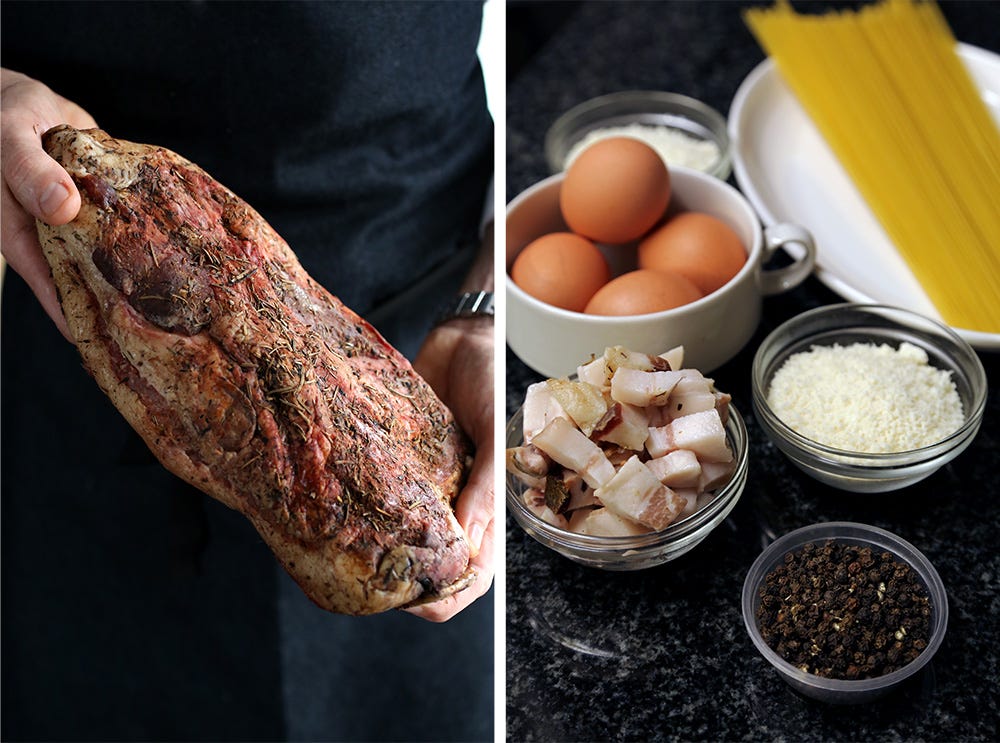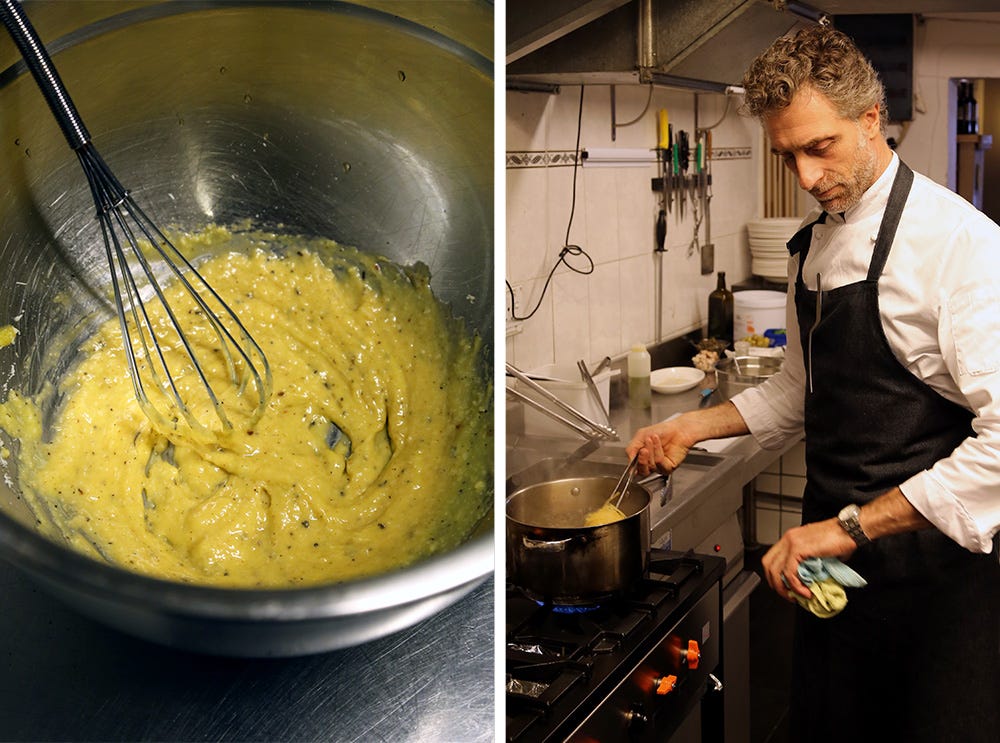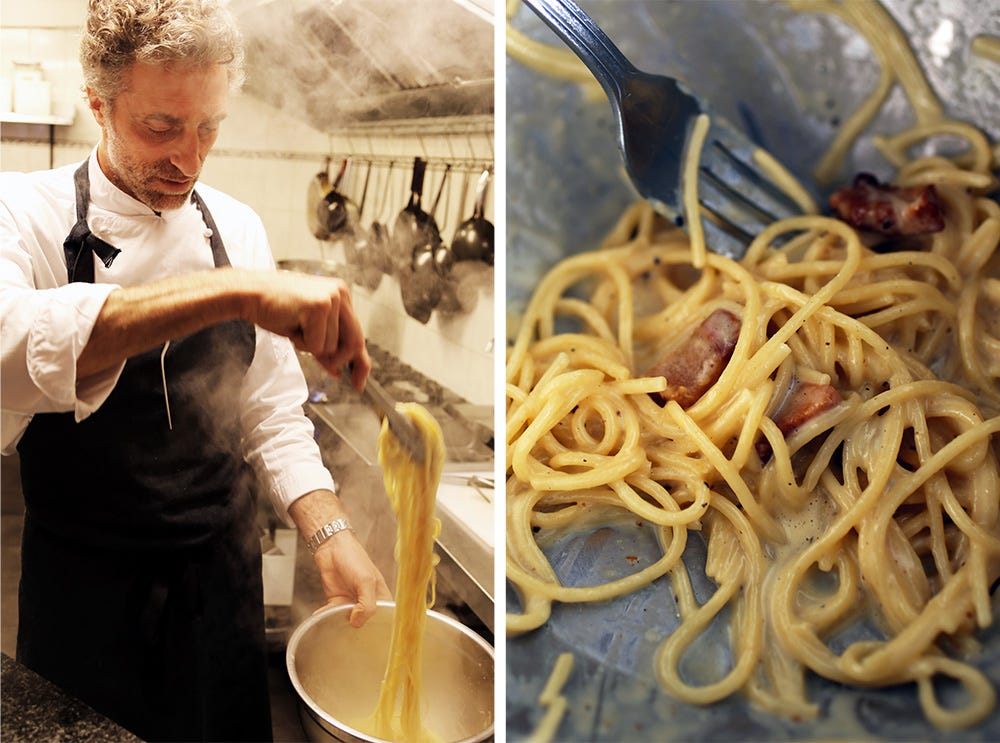Of all the pairs in the step-by-step below, this is the picture to memorise for perfecting carbonara. On the right is the texture to aim for just before serving, and on the left is the key move: treating the sauce like a kind of savoury custard by cooking it over a double boiler. Here the chef, Andrea Volpe, is working freestyle by holding a bowl over the steam coming off boiling pasta water.
Andrea had a restaurant called Pesce Azzuro that we visited regularly, for the way he cooked fish and the way he cooked carbonara. He comes from Livorno, so fish and seafood are his calling, but he honed in on carbonara when working alongside chef Luciano Monosilio – who is attributed with codifying a modern approach to cooking it and who Andrea is quick to credit.
Observing Andrea make carbonara revealed five key moves that forever changed the way we make it at home. And on reading Luca Cesari1, although his ratios vary slightly, he confirmed the core principles and closed the gap by offering some precise temperatures (see below).
Here are the key take-homes:
Use egg yolks instead of whole eggs
Add the rendered guanciale fat
Cook the sauce over steam or in a double boiler
Add some pasta cooking water to the sauce
Add guanciale at the end for a crisp contrast
Guanciale + egg yolks (no cream)
For two people you will need:
Guanciale | 200g
Andrea: ‘The cheek is better for carbonara because there is more fat.’ And you will need some of the rendered guanciale fat to make the sauce.
Egg yolks | four
Parmigiano Reggiano | 35g finely grated
Pecorino Romano | 35g finely grated
Granoro Spaghetti Ristoranti 14 | 200g
Andrea: ‘The no. 14 in this brand is thinner than your average spaghetti.’ This specific spaghetti in this quantity is boiled for exactly five minutes before tossing with the sauce. Using a thicker spaghetti will mean adjusting the cooking time slightly.
Freshly ground black pepper but no salt
Andrea: ‘There will be salt in the pasta water and the guanciale is salty enough.’ The Pecorino lends saltiness too.
Cook the guanciale and save the fat
First clean the guanciale by cutting off the skin (this can be added when cooking beans to make them more delicious). Then scrape off any herbs or seasoning. ‘We want it to taste like pork, not like the seasoning,’ explained Andrea.
Slice the guanciale into 1cm thick pieces and cut those into cubes. Add the cubes to a pan and set over a high heat – just to get them started. Once they’re sizzling the heat is turned down to medium and they cook for around 10 minutes or until the fat has rendered and they are the colour of hazelnuts.
See the picture (below left) to get a sense of the colour once they are cooked. ‘You know they are ready when there are fewer bubbles and the cubes are smaller,’ advised Andrea. It’s worth mentioning that they are not completely hard and crunchy but more like juicy cubes with a thin outer film of crisp.
There will be a lot of fat that renders during the cooking – we’ve measured around three-quarters of a cup – so spoon it off into a heatproof bowl as it pools in the pan (and freeze or refrigerate for your next carbonara) so the guanciale doesn’t deep-fry in its own fat.
Once the guanciale is ready, transfer to a plate lined with paper towel and reserve the rendered fat. As Andrea says, ‘The fat is where the flavour is,’ so it’s added to the egg mixture that will become the carbonara sauce. First it needs to cool so it doesn’t scramble the eggs as it’s added, which can be accelerated by putting it in the freezer for a bit.
Andrea worked ahead by storing the fat in the fridge and using some from a previous round of cooking guanciale, so there’s no need to wait for the just-rendered fat to cool. He just made sure to bring the refrigerated fat to room temperature before he began.
Cook the sauce over steam or in a double boiler
Note: from here on out it all happens quickly and once you start there’s no stopping until serving. So have everything ready: your wine poured, your serving plates and cutlery in place. It’s going to take around two minutes of cooking the egg mixture on its own (as the pasta cooks) and then another five minutes of cooking it with the pasta.
To make a double boiler, find a large, glass heatproof bowl that fits snug on top of a small pot. (Andrea’s freehand double boiler was efficient for a restaurant kitchen, but we found a pot-and-bowl set up easier in a home kitchen.)
Fill the pot with water until about a third full – the water should never touch the bottom of the glass bowl, the eggs are only heated by the steam produced. Place the pot on a burner on the stove and bring the water to the boil.
Add the yolks to the bowl (not yet on the pot) and whisk in the cheeses so it resembles a paste. Whisk in two tablespoons (30ml) fat and a generous grinding of black pepper.
For the pasta, have a colander set over a bowl at the ready (prefereably nearby or on your stovetop) and heat a large, stockpot-sized pot filled with cold water over the highest heat until the water comes to a rolling boil.
When you’re ready to begin, start by cooking the pasta. Salt the boiling water generously, add the spaghetti, bring back to the boil, and cook for 5 minutes.
About halfway through the pasta cooking time, place the glass bowl containing the egg mixture on top of the small pot, allowing the steam to warm the egg mixture in the bowl, and whisking constantly. Before cooking the mixture looks more like a paste, then once it starts warming up over the heat it appears to melt and become more liquid. As it contiues to cook gently it will slowly begin to thicken and resemble a light, smooth custard.
Keep a close eye on what the egg mixture is doing, if it seems to be cooking too quickly or getting too hot, take it off the pot momentarily (and keep whisking) or lower the heat on the gas burner. (If you own a kitchen thermometer and prefer to be precise, you could check the temperature of the sauce periodically, making sure it never goes above 64°C.)
Add the pasta and some pasta water
This is where you need to work quickly – if need be, take the egg mixture off the steam for a moment while you deal with the pasta. As soon as the five minutes is up, scoop out about a cup of the pasta water and, using a pair of tongs, transfer the spaghetti from the pot to the colander.
Then add the bowl of egg mixture back over the steam (if it’s been off in between), whisk well, and using the tongs again, drop the spaghetti bit by bit into the egg mixture – keeping everything moving around in the bowl with a spatula until all the spaghetti has been transferred. Once all the spaghetti has been added use the tongs to keep tossing the spaghetti with the sauce.
Adding some of the pasta water helps create a sauce and Andrea added a little at a time, presumably so as not to increase the overall temperature by adding too much too quickly. He tossed and cooked the spaghetti with the sauce for at least five minutes and it’s simply through practice that you will develop a feel for how liquid the sauce should be. Just bear in mind that as it sits on the plate it becomes less saucy so you can err on the saucy side.
As soon as the sauce looks creamy and is coating the pasta well with some residual sauce all around it (see below right), add half the guanciale and toss well, divide between two bowls and top with the remaining guanciale. By holding some of the guanciale back and only adding it at the end it stays crisp and adds a textural contrast. Finish with some more finely grated Parmesan and plenty of freshly ground black pepper and serve immediately.
Here’s that picture again for reference. Buon appetito!
Additional notes
After reading Luca Cesari, I revisited the method above with thermometer in hand, a packet of spaghetti of average thickness, and the intention of separating out all the processes as a way of building confidence. The ingredients and guanciale cooking remained the same and taking the steps below worked well.
The spaghetti and sauce cooked separately side-by-side for the same amount of time: seven minutes. They were only tossed together briefly over the steam with some pasta water just before serving.
Two tablespoons (30ml) cold water was added to the egg mixture before cooking.
A kitchen thermometer was used to check the sauce during cooking to be sure it never exceeded 64°C.
The spaghetti was allowed to cool slightly before adding as Cesari makes the point that pasta shouldn’t exceed 70°C to avoid raising the temperature.
A Brief History of Pasta: The Italian Food that Shaped the World by Luca Cesari (London: Profile Books, 2022)








